|
译者:@李姬韧 我们花了3年时间完成《风之旅人》(Journey,简称《旅》)。我们的公司,ThatGameCompany成立于2006年。在最初的三年里,我们做了《流》和《花》,和《旅》一样都是PlayStation主机游戏。 这是在《旅》完成时,我们的团队全家福。 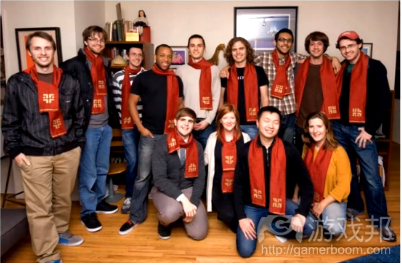 团队全家福
我们庆祝的时候,给每个成员做了和《旅》中一样的围巾。我们是一个12人的小团队。 当我们开始设计《旅》时,我们团队有7个人,刚刚完成《花》。当然,在《旅》的设计过程中,很多人来,很多人走。他们中的很多人昨晚也在台上。 在《旅》之前,我们确实已经得过一些让我感到自豪的奖项。不过在《旅》发布之后,这个事就有点疯狂了。。(大把大把的奖) 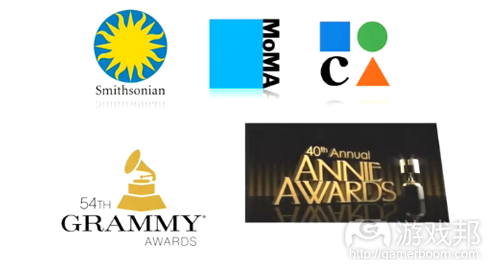 跨领域奖项
我最感到骄傲的,是这些跨游戏与博物馆,艺术以及其他领域的奖项和提名。因为在内心深处,我总是希望游戏被更广泛的大众认同。 我们是如何做到的 很多人问,你们如何做到的。你们甚至没有一个公关部门。你们的CEO却总是上新闻。我想这是因为我们以一个不同的视角来看待游戏设计。我记得在2004或者2005年的GDC(游戏开发者大会)上,我们在讨论游戏机制的创新。有很多不同的方式来创造创新的游戏。你可以研发新的技术,应用它来设计新的游戏;你可以设计独具一格的艺术风格,应用它来设计新的游戏。而当我们想要创新时,我们从情感的角度来看这个问题。 互动媒体 我把游戏视为娱乐的一种。当你把娱乐作为一个整体来考虑,它是一种用来满足人类欲望的产业,就像食物和水。当一个人产生了对情感的追求,他可以通过多种多样的媒介以多种多样的方法来满足。而恰好是游戏这样的互动媒体提供的娱乐,可以带来非常多样的情感体验。 把游戏和电影对比,我们可以看到电影已经非常成熟,沉淀出了可以以情感色彩来区分的不同类型,从消极情感到积极情感。  情感色彩
情感调色板 我们来看看游戏的类型,尤其是早期的游戏。这些(《俄罗斯方块》,《愤怒的小鸟》等)是我认为的街机时代,尽管我把《愤怒的小鸟》和《宝石迷阵》也包括在其中。这些游戏在早期是非常流行的。他们都是关于成就感的游戏。你可以在一项技能上越来越精通,并获得成就感,这是一种在电影中很难获得的强烈的情感体验。我想这是为什么,在游戏早期阶段,我们探索最多的就是这种情感。 在过去20年里,游戏变得越来越大,尤其是主机游戏,以青少年和年轻男性玩家为主流受众。针对这些群体的游戏,很多都是关于力量感(empowerment)的。想想这个群体的玩家需要什么?在学校他们被要求不能做这不能做那。在家,他们不能开车不能喝酒,什么都不能。学校有很多对自由的限制,所以,自由的感觉,是非常吸引这个群体玩家的。但是随着我长大,我有了自由,我有了工作,有了钱,可以去任何我想去的地方,我就发现这种 自由感觉的游戏不那么吸引我了,我越来越少玩这些游戏。如果你看一下游戏在情感上的创新,比如模拟人生Sims,它是第一个让我感觉到我能和别人社交的游戏。这是非常厉害的。那个时候甚至还没有多人联网游戏,这个单机游戏就给了我与他人的一种建立情感联结(connection)和人际关系的感觉。我想这可能是为什么它能非常热销并且对不同群体的受众有不同的魅力的原因。所以当我们创立ThatGameCompany时,我们就想要扩展游戏所能带给玩家的情感,开辟更大的情感体验空间。如果在游戏中你能体验到多种多样不同的感受,那游戏将可以成为一个健康的媒介。对于玩家,如果所有的玩法都是施加强力,而同时有了一个新的体验和感受,那这个体验对他们也是健康的。 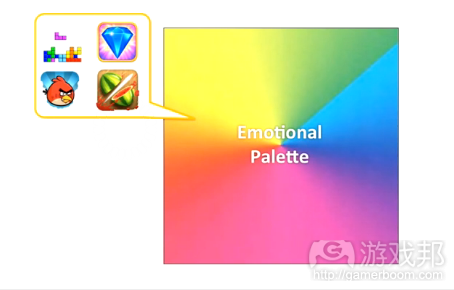 情感调色板1
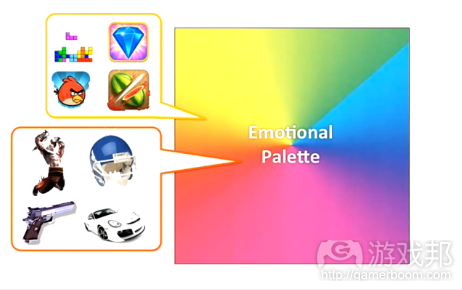 情感调色板2
 情感调色板3
《旅》 现在我们来谈谈《旅》。早在2006年,ThatGameCompany成立之前,我已经有了关于《旅》的想法。 那是是我玩魔兽世界的第三年。我从封测开始玩,因为我有朋友在暴雪工作,当时我很荣幸能这么早玩到这个游戏。 但那时,我已经开始厌倦魔兽世界了。因为当时在读书,大部分时间我很忙,几乎没有社交生活。在网上,和其他人在一起,真实的同样在网上的人,是能让我感觉的亲密和不那么孤独的。 当我在网上玩游戏,我渴望与他人有情感交流,我希望有爱情和友情。 但大多数时候,玩家们不关心这些事情。他们喜欢讨论的是战斗策略,怎样干掉BOSS,一直想着怎样打到一件好装备。“这轮是我的,不要跟我抢”。我觉得有些失望,因为我越玩这个游戏,我在游戏里遇到越多的人,我越意识到我与这些人之间没有情感联结。这一切只是更加提醒我,我是个孤独的人。我觉得很悲哀。我希望有一种不同的游戏,满足我的需要,让我能和其他人形成联结。 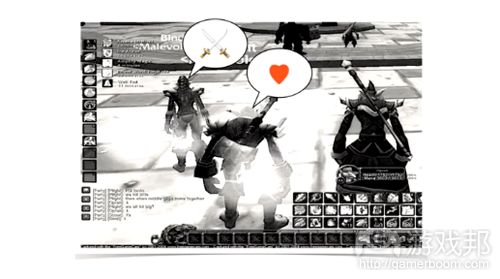 游戏与情感
我是一个内向的人,不喜欢派对,酒吧。所以我想象着一个线上世界,能够让人与人之间没有差别,没有敌人,没有装备套装,没有“我是白金套装你只有青铜套装”。我希望这个世界中的每个人能够忘记那些物质的事情,而关注我们都是人类这个事实。 另一件让我很郁闷的事情是,很多人都想知道在游戏里遇到的人到底是男是女。当然结果总是让人失望的。我希望有一个不区分年龄和性别的游戏。有时当我想到和我在游戏里产生情感连结的人其实是一个12岁的小男孩,我顿时觉得很失望。我想要一个游戏世界,里面每个人都是一样的,没有性别之分,每个人都在自己的路上,寻找着什么,寻找着一些我不知道是什么的东西。  瀑布
我很喜欢这个画面,当一个人只是站在桥上,看着山上落下的瀑布,我在想象一个情景:我静静的走向他,什么都不说,而他一直看着瀑布,我决定停下来,也看着那瀑布,思考他为什么在那看,这样站在一个人身边,而不是继续向前走。这个场景让我感觉,这一刻我们两个人是心灵相通的。 然后我在思考关于MMORPG,因为当我在玩《WOW》时,有很多玩家。有一个我很想在WOW里看到的场景,是旺达与巨像的场景。这多么荒谬。在这个场景中,有些黑暗的柱子,其实是巨人的腿,人们走过雪地,踩过所有的尘土。这里雾很大,灰尘也很大,看不清前方。这些人保持安静的走着,因为如果出声,巨人会注意到你。你只能缓缓的前进,依靠你前面的人带着你远离危险。同时给你后面的人以依靠。这是一种我很想要体验的情感。 钱 当时当年公司创立之初我们没有钱,也没有投资。我们很幸运的和索尼合作开发了前两款游戏,《流》花了一年,《花》花了两年。  Flow & Flower
所以当我们完成了《花》时,我们决定做第三个游戏。我觉得我们有能力做一个联网游戏了。所以我们带着我们从《流》和《花》中学到的经验,开始做一个能够给两个陌生人带来一种新的情感体验的游戏。 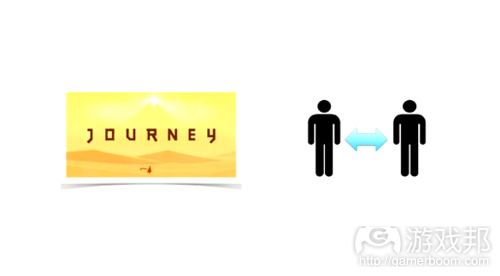 Journey
这里我们要岔开一下,继续说之前讲的情感体验。我们提到过模拟人生这样的社交游戏。在2009年,当Facebook兴起时,社交游戏也爆发了。当时所有人都在谈论社交游戏。当我来看这些社交游戏,这些互动的机制设计,这不是关于社交的,而是关于交换数字和资源管理的游戏,这让我觉得其实更多是早期游戏。 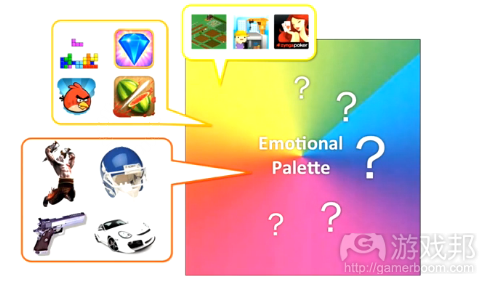 情感调色板4
当我们想到社交这种情感时,《模拟人生》是一个。当我玩《吉他英雄》时,我和跟我一起玩的人有很强的社交情感连结。甚至当我玩《我的世界》(Minecraft)时也是这样。虽然《我的世界》是最近的游戏,但是他的互动机制确实让人得以社交。  情感调色板5
我在之前做的两个游戏中,都希望做出强烈的与众不同的情感体验。我知道有些情感体验会让人产生情感连结(bind people)。我希望人们可以在这个游戏中体验到非常深的情感。但我不知道那具体是一种什么样的情感。 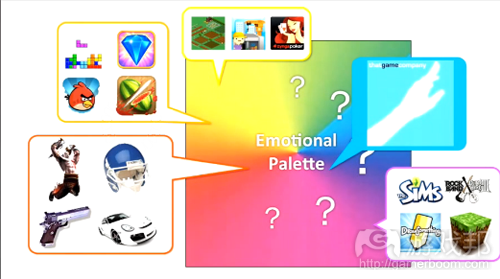 情感调色板6
找到这种情感 我们花了很长一段时间来寻找,在社交互动背后的情感体验到底是什么。 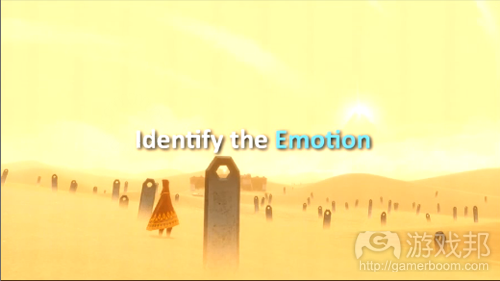 Emotion
我看了其他很流行的主机网络游戏。很多是关于团队作战,或团队生存的。有一个很有意思的事情是看看那种“平均噪音”(average noise):人们总是说他们多么讨厌网游玩家,他们在网络上很不友善,也不想知道他们是谁。我很想做出一些不一样的东西,让人们互相更信任。 我非常有幸能够见过一些宇航员,并且和他们聊在太空中的体验。 他们谈到了一个很奇特的谜题:每个月登过月的宇航员,当他们回来以后,都变得非常追求灵性和宗教的东西。这听起来像是一个餐桌上的笑话。但是月球一定有一些神秘的东西,改变了那些去过那里的人。 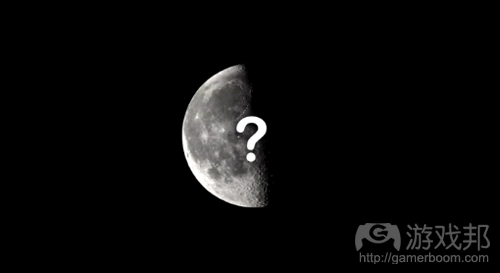 月球
后来我认识了一位登过月的宇航员,我问他月球上到底有什么特殊的,让这些回来的人感觉到不同的东西。他说:“在月球上,什么都没有。连声音都没有,因为那里没有空气。难以想象的安静。在那里,地球看起来那么小,好像有大拇指就可以把它遮住。所以你到了一个奇怪的地方,什么都没有,异常安静,你无法不思考为什么,为什么我们在这里?宇宙的其他地方是什么样的?你所知道的全部东西(这些宇航员都是科学家,他们知道关于地球的很多东西)突然间我们到了一个充满未知的地方。” 我学了心理学,知道这是敬畏与未知的感觉,并且是和很多宗教的思想相通。 但这种灵感你无法和一个游戏联系起来,但是他启发我审视我们今天的生活。我们被科技和知识赋予了强大的力量。我们可以飞速的移动,可以住在云层之间,可以在任何时候和任何地方的任何人交流。我们可以把人类所获得到的全部知识装进我们的口袋。如果我带着这些东西回到十年前,他们会觉得我是上帝了。我知道任何事情,可以做任何事情。但这也让我觉得我们的生活被这些力量捆住了。我们离开这些就无法生存了。 当我们看看游戏,尤其是流行的商业游戏,大部分角色都拿着一些象征强力的东西。 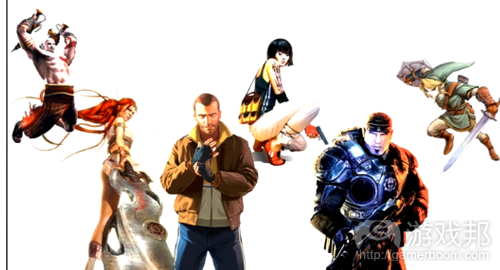 商业游戏
游戏的玩法,也都是关于力量感的。当你有了力量,你把一群人放在这种环境里,他们的第一反应是把这种力量施加到别人身上。如果你给我一把枪,把我和其他人关在一个房间里,我想我总有一天会用这把枪的。所以问题是当你拥有强力时,哪怕这本是个生存游戏,团队合作游戏,大部分的时间,你也在施加强力,比如开枪打死其他人。当我的队友挡住我时,我的反应是,让开,让我打死这个僵尸。 我在《求生之路》中感觉到和他人有情感连结的唯一情况,是当我和他人在相互治疗,那时我确实有所触动。但是不幸的是这种情况太少了,大部分的时间我都在向他人施加力量。 重新设计网络游戏的体验 所以当我想重新设计一种社交的体验,一种能够把人的情感连结在一起的体验时,我觉得第一件事就是反转玩家和游戏世界的力量对比。玩家要变得缺少力量,而怪物要变得非常强有力。 然后,我来考虑玩家之间的合作。今天的很多游戏,都是关于成就,挑战,和征服怪兽的。这使得怪兽其实看起来像天使一样一直给玩家宝物。我看到在一个网络游戏中,大多数人考虑的是怎么获得宝物,变得更强,而很少考虑其他玩家,尤其在WOW中,除非Boss太难我打不过,否则我根本不会想到其他人。我只想让他们帮我打BOSS。我把他人当做追求宝物的手段。 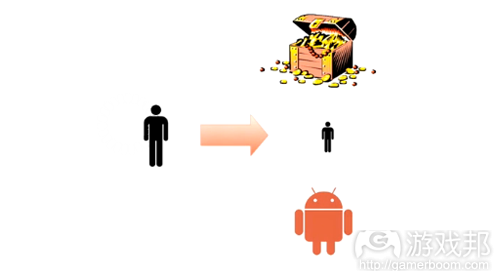 玩家vs游戏世界
我同样希望这种情况反转过来。我希望宝物和怪兽成为手段,成为一种让我能看到其他玩家有多么伟大的手段。 大部分网游是关于射击的。而我希望看到在一个游戏中,玩家获得和增强的不是他的枪法,而是能够与其他人交流情感,并感受到其他人的能力。 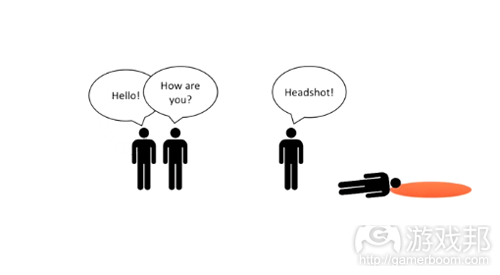 交流
问题是创造一个这样的世界很难,因为大多数游戏中,战斗的场景有太多杂音。当坦克,武装直升机在开炮时,你没有时间去好好看看你身边的人。 所以我想,那好,我们把这些杂音都去掉,我们让一个游戏只有人,只关注人。 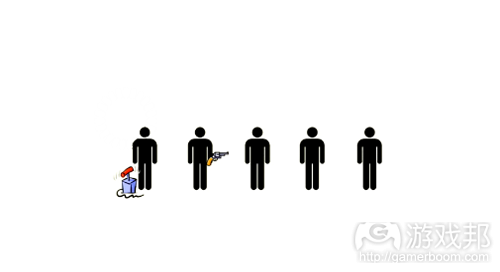 只关注人
然后,如果你有一把枪,你就会想要用它。我们当然要把它去掉。然后这个场景很有意思了,一群人聚在一起互相交谈,好像等待仪式开始。 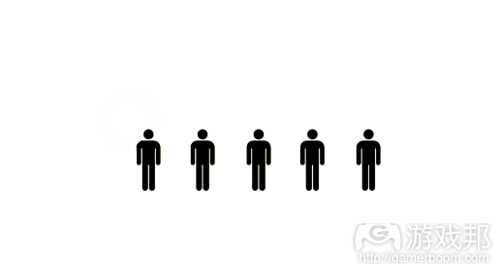 等待仪式开始
但是我想要有更多的世界构建,所以我想如果我们有更少的人会怎么样?有更少人时,我们更容易设计。所以我们设计了一个灾难过后的世界,很少人存活下来。然后我们就只有两个人了。  只有两人
相比于永远不停的战斗场景,突然,一个在远方的人变得那么有意思。 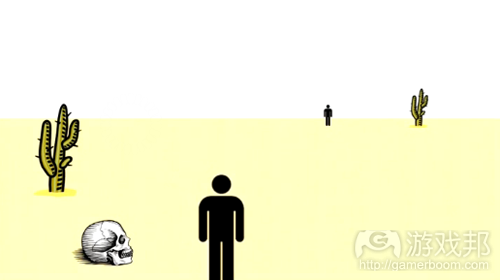 孤独感
这就是《旅》的设计的开始。我们希望做一个让你感觉到孤独和渺小的游戏,同时你有一种很强的敬畏感,对眼前这个神秘游戏世界的未知感。 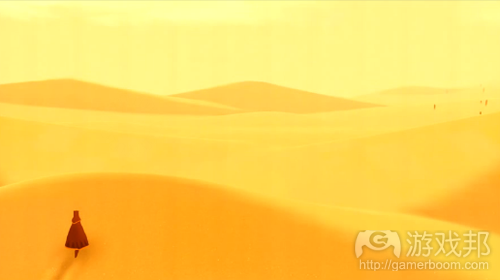 Journey
设计情感原型 这就是我要找的情感体验。但想要把这种情感体验做出来,我们需要做很多原型设计,因为很少有游戏试图做这样的情感体验。也许《迷雾》(Myst),《旺达与巨像》是唯一两个让我能感觉到类似情感的游戏。 最初4个月 开始开发四个月以后,我们的设计师在这段音乐的基础上做出了这个预告片。 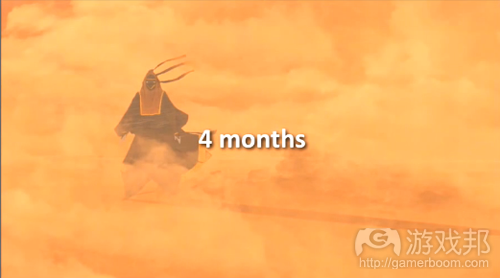 最初4个月
你可以看到,在当时,我们的主角看起来像一个忍者。他仍然有手臂,更像一个人形。这还是非常早期的造型。但是我们知道这个世界让你觉得宏大和触动。你会感觉到敬畏。这是包括了多样的地形。你们一定听过这段音乐,这就是我们在最终发布的游戏中用的音乐。这个音乐在我们发布《旅》之前就在各种媒体上发布了。它完全没有被改动。它让我感到一些很强烈的东西。我们就是围绕着这个音乐来做出了整个游戏。终点的山曾经是一座峡谷而不是一座山。 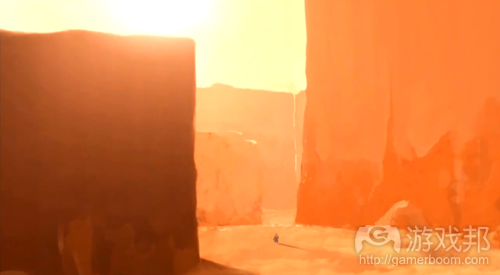 峡谷
早期原型 然后我们开始遇到各种问题。这个预告片只是在早期很成功。下面我来讲讲开发过程中我们学到的。 合作体验与单人体验 我们第一步着手于合作的设计。我们希望玩家们能够很好的一起合作。 我们最初设计了一个被称作绳索的原型。这是一个只有一个按键的游戏,你只能按空格键,做出使用绳子的操作。这里有一个一个瘦长的人无法打破石头,因为他没有手。而这个胖人,他很强壮,可以一定概率打破石头。他们合作利用绳索爬上去。这个瘦长的人可以跳过地上的沟。他可以随时伸出一个绳子,拉胖人过去。这样他们就可以合作了。我们觉得这个设计很好,人们会互相帮助。但是问题是我如果只有一个人就完全没法玩。索尼不断告诉我们,你们设计的游戏不管有多棒的多人体验,也必须有一个单人的玩法。否则你没法卖你的游戏。所以我们知道,这个方案不行。 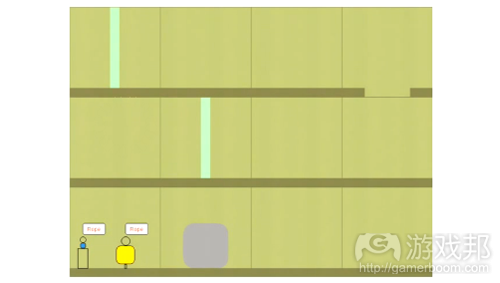 绳索原型1
 绳索原型2
 绳索原型3
 绳索原型4
还有一个两个人合作推石头的原型,这在很多合作游戏中都有。但是如果你只有一个人,你就无法完成这一关。尽管有很好的合作的感觉,但是如何设计一个能单独玩的游戏,成为了我们一个很大的挑战。 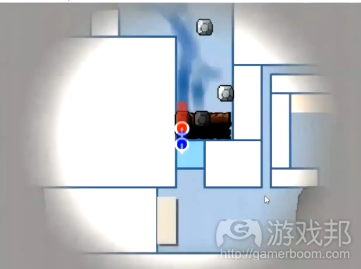 推石头原型1
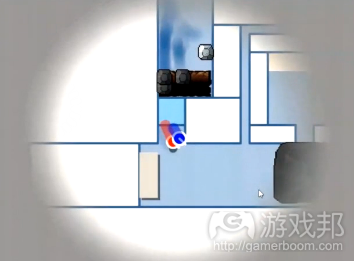 推石头原型2
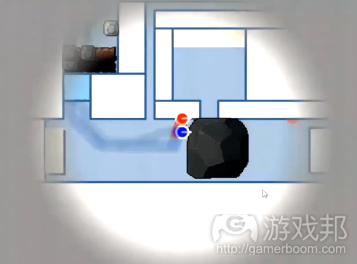 推石头3
2D原型不等于3D适用 另一个问题,你可以看到我们早期的大部分原型设计都是用JAVA和flash做的2D原型。在这些原型中有些看起来很赞的设计,根本无法在3D下做出来。 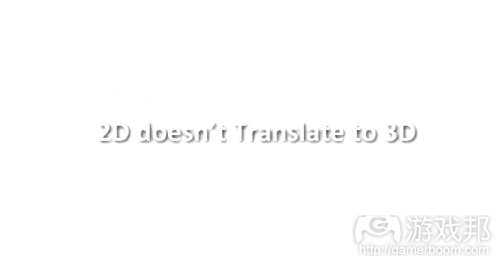 2D不同于3D
我们做了足迹路径的设计。当你走在沙漠里,以这种顶部视角,你只能看到这么大范围。你如何能知道旁边有另一个玩家?就算那个玩家在那里,你们以相同的速度向同一个方向走,你也无法追上他。 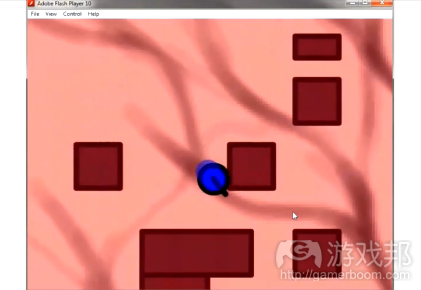 足迹路径1
 足迹路径2
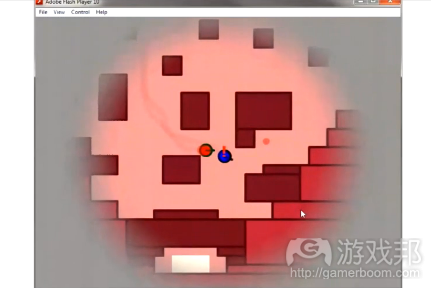 足迹路径3
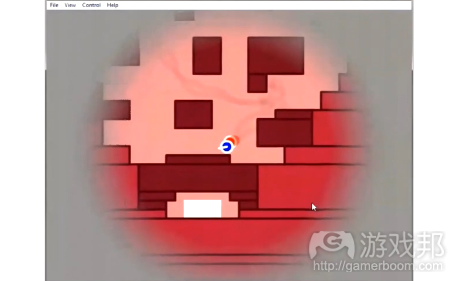 足迹路径4
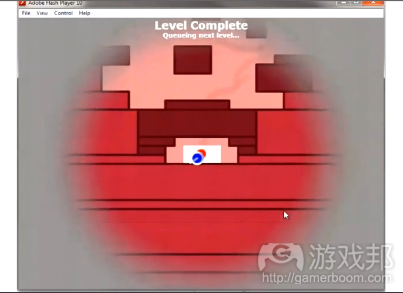 足迹路径5
我们设计为,当你走在其他人的足迹路径上,你会加速。这样,最终当你四处探索时,你会找到其他玩家。这些是早期原型中的截图,我们当时觉得这个设计很成功。 我们还试图提示玩家,当他们在一起时,他们会变得更强壮,可以爬过岩石。 但是当你最终试图把这些机制转为3D时,因为摄像机镜头等原因,你几乎不可能实现。 这里是另一个原型。当两个人走在一起时,他们会制造烟雾,使得两个人都走的更快。我们觉得这个设计很聪明。  足迹路径6
还有一个很有意思的点子:呼叫来分散怪兽的注意力。在《旅》中,你们见过这些怪兽。当你对它呼叫时,它会来攻击你。 所以当两个人在一起时,你们可以合作吸引怪兽注意力来通关。但是当我们把这个想法做成3D时,发现3D视角下,玩家几乎不可能判断自己和怪兽的距离,从而不能做出有效的合作。  3D视角1
这些案例让我明白,对一个策略机制和合作的玩法,顶部视角非常好。但是3D中就几乎不可能做出来。 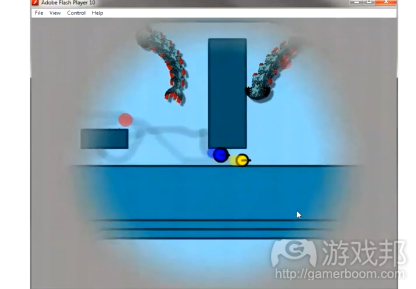 3D视角2
这里是另一个我们觉得非常棒的但是最终被干掉的主意。这个原型里有沙漠和沙尘暴。当沙尘暴来临时,人们要找的藏身之处,比如图中灰色的地方。你可以看到沙尘暴一直在吹。如果两个人在藏身之处过于亲密,他们会变成粉色。也许是他们害羞了吧。这个沙尘暴铺天盖地的场景给人非常强的情感体验,但是最终当我们想在3D中实现时,我们才意识到要做一场沙尘暴有多难。 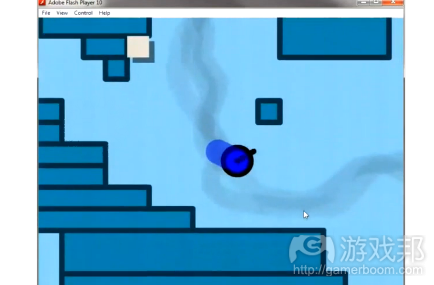 视角3
 视角4
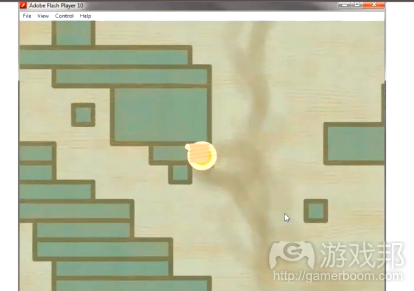 视角5
 视角6
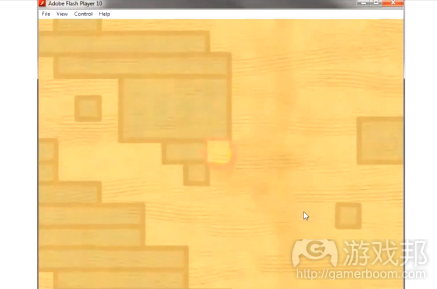 视角7
画面也是玩法体验的一部分 同时关于画面即玩法的理解。在Thatgamecompany我们叫它Grameplay(画面设计带来的玩法)。我们更多是一个专注于以画面设计创造玩法的公司而不是以机制设计创造玩法。  画面也是玩法
举个例子。想象一下你在沙漠里,走向一座远方的山。你一直在走,但是山这么远,屏幕上似乎什么都没有变化。  走在沙漠中
这就是《旅》在早期时的感觉,所以我们当时不得不在地上设计光点使得玩家感觉他真的在前进。我们把这个游戏世界构建的非常大,因为我们想让玩家感觉到史诗般的宏伟世界。但是在这样的土地上前进,确实很无聊。有很长一段时间我们觉得这个游戏一点也不好玩。  在地上设计光点
 光点2
为了让简单的走路这样的体验也能有反馈,我们增加了日照下的阴影。至少你有了一些东西,让你能够感觉到你走了多远。我们增加了很多沙丘之类的物件让你可以越过,这样屏幕上的画面不断给你反馈,而不是让你盯着一个持续不变的画面。 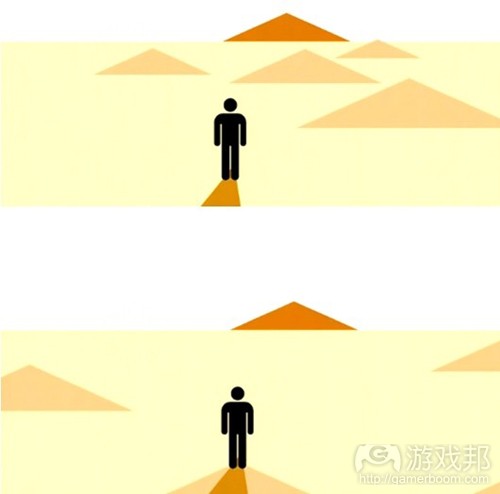 日照下的沙漠
我们去了一个真的沙滩。这里有一个视频,我们的主程序John Edwards爬上沙丘。然后我想,你跳下沙丘,看看能不能滑下去。然后他试了,发现坐进沙里就卡住了。这个体验太差了。 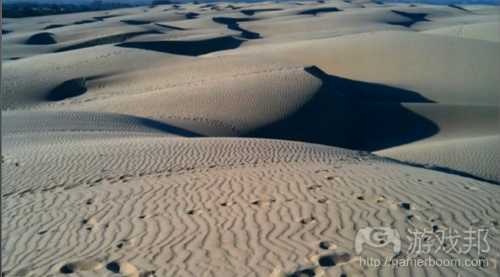 真正的沙漠
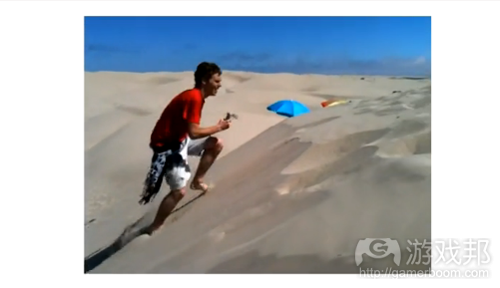 沙漠2
我希望在理想的世界中他可以顺畅的滑下去,所以我们在《旅》中这样做了。你爬上去,爬的很慢,最终你从另一面很顺畅的滑了下来。  滑行
这也有点奇怪,我们想要捕捉现实的感觉,但其实我们在捕捉我们理想的现实。 这样一来,在沙漠中行走变成一件有意思的事情,因为每次你爬一个沙丘,你会期待沙丘后会有什么。你还有一个奖励。这样基础体验的沉浸感大幅提高了。这里完全没有游戏机制的设计,只有反馈。 避免分散注意力(distraction) 我们设计这个游戏的过程中,发现了很多让玩家分心的情况。作为一个好的游戏设计师,你需要非常清楚你想要什么体验,并且坚决远离那些你不要的体验。所以《旅》是一个交互界面非常简单的游戏,因为我们希望人人都能玩。我们希望让我的爸爸或妈妈能够在这个游戏中得以享受,而不是要学很多东西。 当我想到一个联网游戏时,我首先想到联网的交互界面。这是《旅》的交互界面。你看到了另一个人,你就知道这是一个联网游戏了。 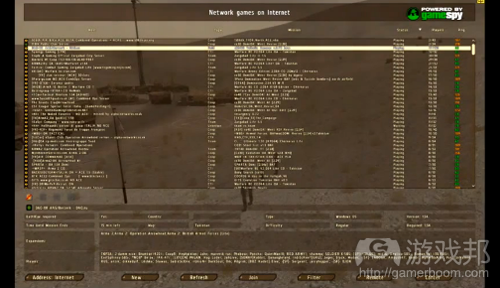 游戏大厅
在我们做《旅》之前,我们想到联网游戏的时候,他们都是这样的。你需要进入一个大厅,找到一个房间,确认每个人的pin码,然后等到全部都变绿之后开始游戏。还要点下“我准备好了”的按钮。我到现在也不知道怎么跟我妈解释pin码是什么。所以我们决定要彻底隐藏这些界面。 下一个问题,是用户名。因为玩家在玩进攻性的,竞争性的游戏,所以他们的名字也常常很有攻击性。这里图中的名字已经还好了。但这些名字把我带出了游戏世界。Haris Pilton,它提醒我我看到的是Haris Pilton,是现实世界。我们花了这么大力气把玩家置身于一个魔法世界。而这些名字,这些文本,瞬间把他们推回了现实。要让玩家们合作和产生情感连结,他们必须忘记这些现实的东西。 下一个问题。玩家会说,在网络游戏中,我需要和我的朋友们交谈,我需要有语音聊天频道。但是在玩主机游戏时,我并不需要听到一个12岁男孩的声音,谁知道对面玩游戏的是什么人呢? 索尼告诉我们,如果有邀请好友的功能,我们就可以获得免费的病毒营销。因为和朋友一起玩是很开心的。他们会告诉其他朋友来买我们的游戏。我们觉得这是个好主意。但是当我们实行它的时候,我们发现如果两个陌生人无法交流,他们会觉得没问题。但是如果我和我最好的朋友一起在网上玩游戏,而我们不能交流,这就很郁闷了。因为这个原因,我们最终放弃了好友邀请的功能,因为它破坏了我们所构建的世界的完整性。 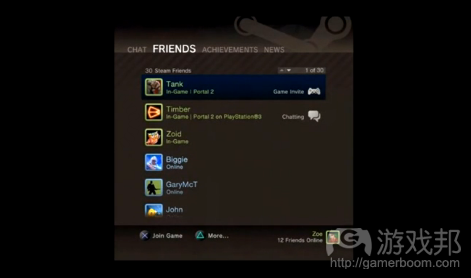 玩家ID
我们唯一允许玩家交流的方式,是在游戏的最后,我们会展示出来你遇到的所有人的ID。用这种方式,我们可以保护陌生人之间的感情。 社交方面的注意力分散 另一个分散注意力的点:在早期,我们设计了四个玩家一起玩。我们发现那成为了一个很尴尬的情况。玩了一会以后,玩家们就开始说“我们”和“他们”。我们非常不喜欢这个情况。当然,有竞争在网络游戏中是好的,但是这不是我们希望设计的情感连结。 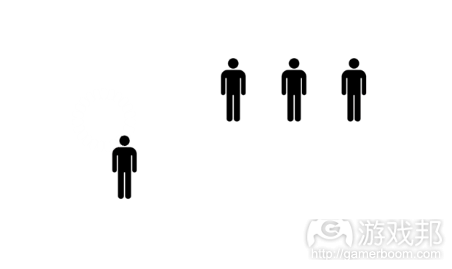 三人行一人落单
更差的情况是有三个人聚在一起,一个人落单。我记得当时和我的教授Tracy Fullerton聊(她也坐在这里),她说她讨厌这个游戏。因为她是一个探索者,她希望探索这个游戏世界,但是其他玩家只想前进。她觉得她被迫要和其他玩家保持一致。 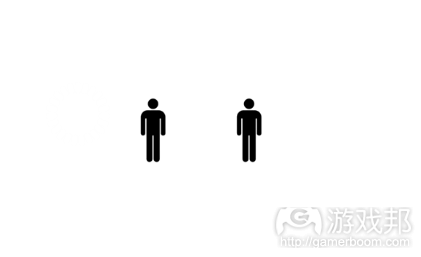 一对一互动
所以最后我们做了一对一互动的体验。也因为3人对1人这种特殊情况带来的问题,带给了我们合作和心流的设计想法。 合作与心流 我最初在单机游戏中学到心流的设计,因为心流作为一种心理学理论,是在玩家能力和游戏挑战之间达到的平衡。  心流
你要确定不管玩家进展到游戏的哪一步,他都在这个完美的平衡之中。 同时,我们有了合作版的心流概念——“自由合作”。如同在任何一个小组合作中,需要在个人主义和团队一致两者之间找到平衡。 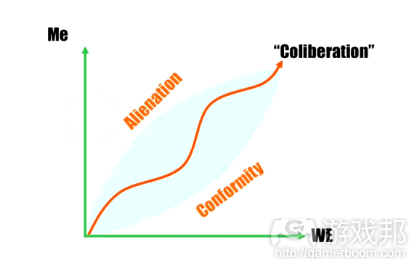 自由合作
我们要给玩家选择的机会,使得他既能够在挑战与能力增长上保持心流状态,又能在团队合作和个人独立性上保持合作心流状态。 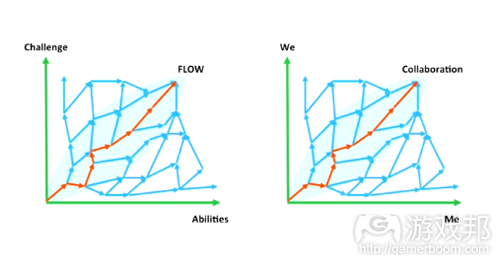 团队合作与个人独立性
因此,我们非常努力的创造了《旅》的无缝联网系统。我们会把你和各种玩家配对到一起。但是有些人可能不适合你。也许他们想要探索这个世界,而你想尽快完成游戏。我们相信如果你有离开一个玩家的选择,最终你一定会找到一个和你想要一样东西的玩家。那时候你们一定会很愿意呆在一起。当你有离开的选择,合作就变得更加真实和发自内心,更有可能创造出强大的情感连结。 最后,《旅》的联机匹配系统是基于现实中的距离来匹配的。如果有个人在离你近的地方,我们会让你匹配到一起。如果你不喜欢他,你离开了,系统会把你们俩断开连结,让你和其他人匹配。 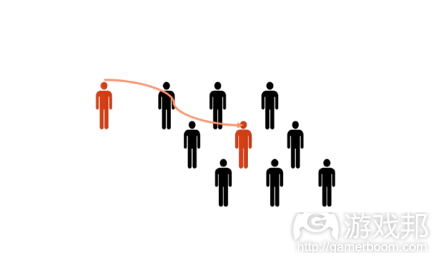 匹配
游戏资源引起的注意力分散 另一种分散注意力的,资源。在《旅》中,你会遇到飘着的长巾,能量,然后你可以飞,并且你会爱这些长巾。当两个都喜欢这些能量的人相遇,而一个人拿走了这些能力,飞走了。另一个人就会恨他。事实上,在我们早期的测试中,玩家说我实在不喜欢和其他玩家在一起,他们不属于这里,他们偷了我的资源。有很长一段时间,为了补偿,我们有过一个很好的主意,我们让玩家把资源用过之后分享出来。他们并不真的消费资源。 这是早期的3D原型,玩家飞的时候,会有能量留在身后,这样另一个玩家就可以获取这些能量,免费的飞了。这看起来是一个没有问题的设计。玩家们分享所有的资源。但是问题在于,从数学角度说他们分享了资源,但是心理学角度并不是。玩家或抱怨,我多么不容易的拿到这些资源,一路上带着这些资源飞,但是我的队友就直接用我的资源飞。他们会觉得队友免费享用了自己的劳动成果,尽管队友并不是故意的。很多人很讨厌这种有人在你背后等着捡你东西的感觉。他们感觉这是一种偷窃。为了消除这种感觉,至少让玩家不怨恨对方,我们放弃了分配资源的想法。我们提供了无限的资源,但是玩家只有有限的能量槽,只能携带一定量的资源。玩家走过资源点,拿到他们的资源,然后他们可以飞,而且不会怨恨对方。 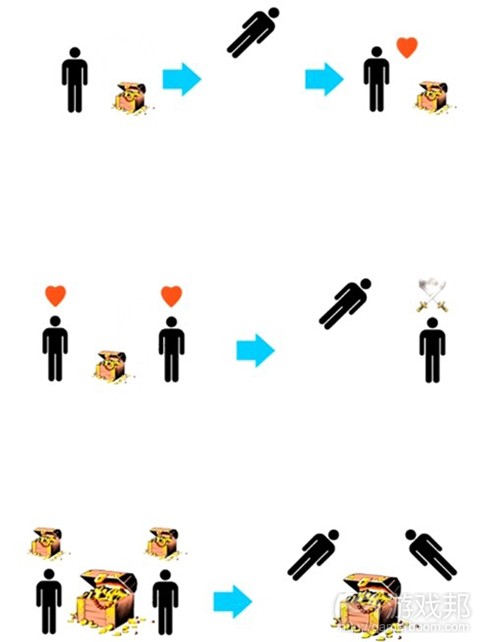 资源分散
物理碰撞带来的注意力分散 接下来,我们有时会遇到物理碰撞设计造成的注意力分散。在多数网游中,是没有碰撞的,所以玩家们可以互相穿过对方。因为网游中的碰撞很难做,而且带来各种问题。 我们曾经讨论过两个玩家互相帮助翻过岩石的设计。在2D原型中这非常容易,但是在3D中,你要扛起队友,把他推过去,等他把你拉上去。所以这里有很多碰撞和物理需要设计。我们想,这些会增进玩家之间的信任,让他们更加互相帮助,所以我们决定做。这会让情感更深刻。  相互帮助
我们增加了玩家之间的物理特性,使得他们可以互相推,能够感觉到对方的存在。这非常棒。 但是,玩家们所做的,并不是把对方推过岩石,而是把他们推向一些更奇特的东西(仙人掌)。有很长一段时间。我觉得是因为这些玩家玩了太多的使命召唤,他们变得这么险恶了。但后来,我们在自己办公室做测试,我们的主程序,把我推到障碍物上杀掉了,很多次。我问他,你知道这个游戏是关于帮助他人和建立情感连结的对吧?为什么你总是在这样做?他只是看着我,大笑,因为我们就在办公室两端,他说:快复活(再来一次?)。然后我意识到,有好长一段时间,我对人性感到失望。有一天朋友介绍我建了一个心理咨询师。我就和她谈了人性的这种困境。她说,因为他们是玩家。他们是婴儿。什么意思呢?当你把你自己从现实世界代入到一个虚拟空间中,特别是一个角色长的像成年人的虚拟空间,你不再保持现实世界中的那些道德规范了。你就像一个婴儿。婴儿只追求反馈。把一个人推上岩石没有任何反馈,但把一个人推死,会有动画,有血,有哭喊的声音,有一股压抑着的社交焦虑等待你去复活你的人物。这更多是关于回馈的。当然玩家想要做有更多回馈的事情。所以我学到了,道德并没有代入到虚拟世界中,为了控制玩家的行为,你要控制输入和输出。 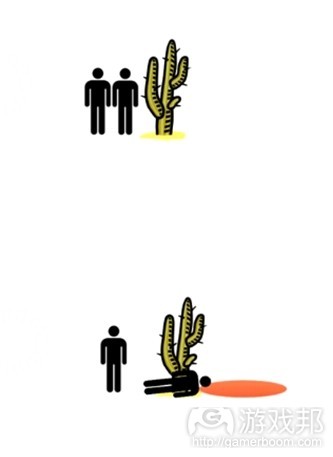 控制玩家行为
为了避免这种情况发生,我们最终放弃了碰撞的设计。为了取代互相推的玩法,我们设计了替代机制:当两个人站在一起,就会给对方能量。所以玩家们就喜欢在一起,因为有很多反馈,而无法从把队友推下悬崖中获得反馈。现在他们共同飞起来了,而且始终保持在一起,爱对方。 这些的细节特性设计可以讲很长。在《旅》的设计测试过程中,持续有许许多多这样的小设计改动,直到这个游戏最终变得好玩。 创造情感宣泄的高潮 现在我来谈谈我认为《旅》中最重要的事情:如果你想搞清楚玩法机制,你必须要创造情感宣泄。情感宣泄是一个故事的高潮。但是重要的是,宣泄不是一种情感,而只是一种紧张度的变化。我认为不管你想给到玩家怎样的情感,不管是快乐还是悲伤,任何一种情绪,你需要达到一个特定的情感深度,一个特定的紧张度。因为否则的话,成年人,包括我自己,我们已经审美疲劳了。我需要被真的震撼到,来感受到一些不一样的东西。  情感宣泄的高潮
三段结构 这个标准的三段结构是来自好莱坞的:你如何组织你故事中的情感紧张度,希望在最后的结尾,有一个巨大的高潮。而这个高潮,就是紧张度的变化,是情感的宣泄。 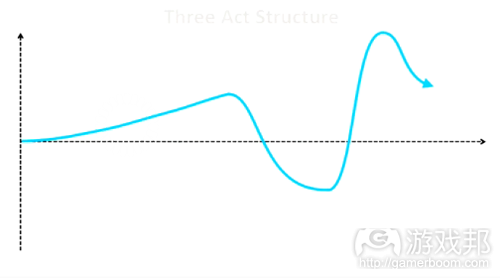 三段结构
敬畏感与神秘感/一个人生转变的故事架构 在《旅》中,这种情感是敬畏和神秘感。我们希望控制这种感觉。所以我去看了Joseph Campbell的作品。他是一个创造神秘与敬畏感的大师。  Joseph Campbell
我就是在这里学到了深度的英雄之旅是如何构造出的。我听过这个概念很多次,但从来没关注过。英雄之旅最重要的故事结构,是关于一个人的改变。 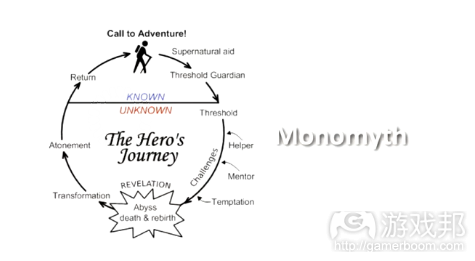 英雄之旅
比如一个农场男孩变成一个拯救银河系的英雄,一个黑客变成救世主,也可以是更抽象的故事,比如一个小狮子变成国王。 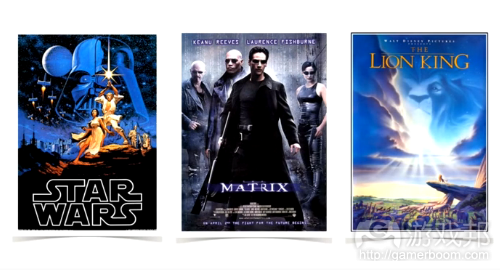 游戏例子
当我把这些英雄之旅的主角人物变化和三段式结构的紧张度变化列成一条线,我想到一个人一生从生到死的变化,这正好是一条线,是一条完美的脉络。一个人的人生,就是一个这么好的英雄之旅三段故事。那一刻,我被震撼了。这如此完美,人们在电影制作中早就搞清楚了这种设计方法。我们要在游戏中尝试它。  游戏进展1
在这个基础上,我们设计了《旅》的情绪曲线,并在这个曲线的基础上设计的地形,《旅》的整个世界。你可以看到,高度上基本就是基于情绪曲线的。然后我们设计了主角从年轻到老的成长过程,并且最后升天。基于这样的故事线,我们创造了对应的情绪和色调,以及这个世界中的每一个细节。 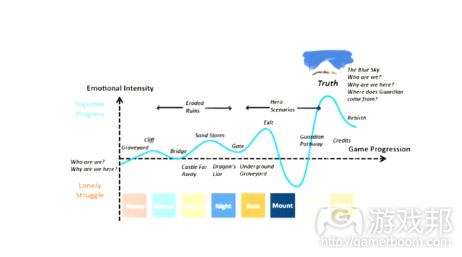 情感曲线
基于这些,我们有了一个更细节的带有玩法元素的情感曲线,分类列在这张表中。我们把图中这些拱形做成更小的一个个关卡。这就是我们第一年的工作,开心的第一年。 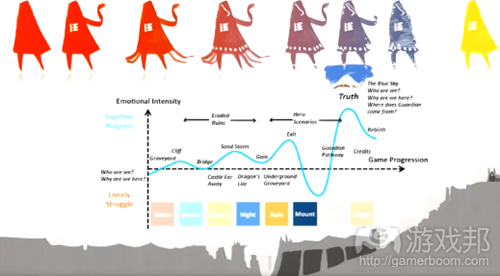 情感曲线2
 情感曲线3
基本上,我们把游戏分解成小的有不同玩法元素、故事元素和历史元素的场景。《旅》中其实有两条故事线。  故事线
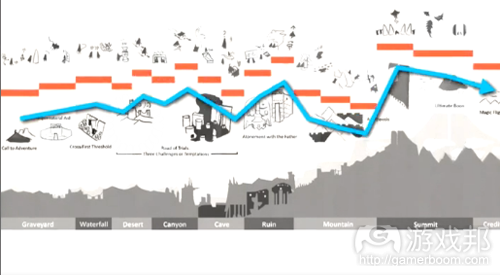 情感体验
在这些曲线的基础上,我们有了紧张度的变化曲线。如果我们把这些画到一个坐标轴上,基本我们就可以用这个来指导我们设计游戏玩法。在积极情绪的部分,我们希望玩家感觉到充满自由,快速运动,充满能量,并相互有很强的情感连结。在消极情绪部分,我们也会给到对应的情感体验。 当我们和美术设计师合作时,我们很容易告诉他去画一个很紧张或很低沉的东西。也很容易告诉作曲家去做出一个感觉到伤心或开心的音乐。但是在设计游戏的控制和玩法时,这个就很难,你很难说什么是一个悲伤的玩法。 我们几乎找不到任何参考。 作为游戏设计师,当谈论乐趣,成就感,力量感的时候,我们有很多专业词汇。但是我关于其他情感的了解,只是通过我自己做过的游戏,《流》和《花》,这样的禅意的,有爱的,平和的游戏。 第一年的最后 我们花了一些努力来探索这些机制,从而实现我们期望的情感曲线。在开发《旅》第一年的最后,游戏看起来是这样了。这是一幅概念图。  概念图1
这些游戏的样子,我们做出了大略的样子。 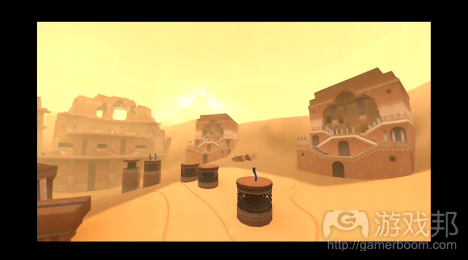 概念图2
第二个桥的区域,应该看起来像这样。 我们有了基础的样子。 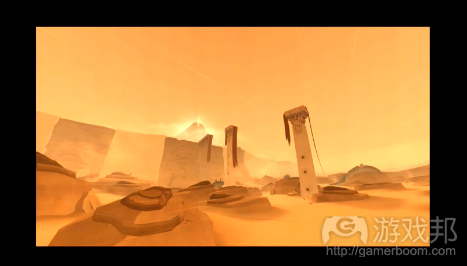 大体的样子
第一年,我们做出了整个游戏大体的样子。我们做出了高山的关卡,地下的关卡。 问题是:这是情感体验的目标。这些当时我们做出游戏的实际感觉。没有任何东西让我有所触动。整个游戏很糟。大家都没有信心我们能把这个游戏做好。 我们继续努力。这是第二年结束时我们完成的预告片。 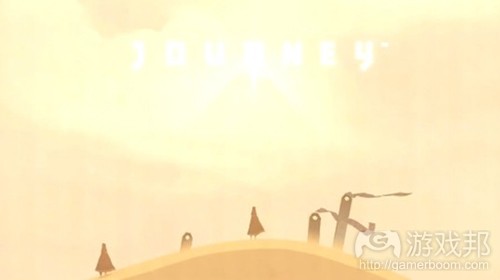 预告片1
你可以看到这和最终预告片已经非常像了,除了沙子没有那么闪亮,有些模型还没有打磨足够。你可以看到角色已经几乎完成了,场景完成了,故事线完成了。 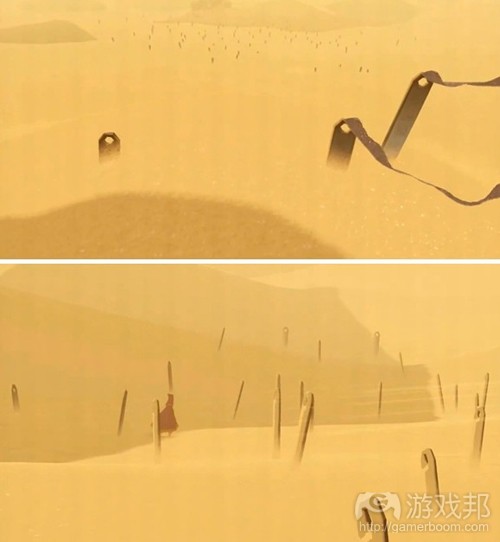 预告片2
这是我们衡量的第二年末版本的情感曲线。基本达到了目标。我们大部分的关卡几乎完成了。我们找了很多玩家来测试,但是结果不好。他们说这个游戏很差。 有人告诉我,在最后天堂的关卡,当人物死去,你们应该就在那里结束,因为后面的部分让整个游戏感觉更糟了。这让我很惊讶。  玩家测试后发现很糟糕
我审视这个游戏,我发现,如果你看着那条绿色的情感曲线,最后的情感升起只有这一点。甚至还没有前面浮水的关卡高,甚至没有更早划沙的关卡高。这不能让人满意。这有个玩家说,当他死了的时候,突然游戏宕机了。 他盯着白屏看了两分钟,没有其他人注意到。他陷入了深深的沉思。他感觉这是一个很严肃的悲剧结局。(大笑)他很喜欢这个结局。我思考,为什么会这样?确实如果你从之前那关到你死去这里的情绪谷底,这是一个最大的情感转变。如果你把它反转过来,这就是悲剧的高潮。但这不是我们预期的。我们不是要做一个悲剧故事。 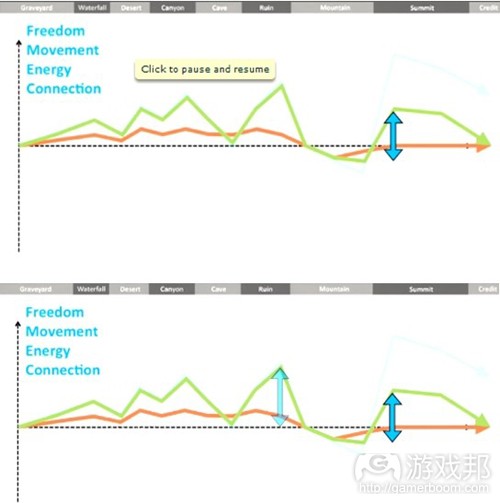 悲剧的高潮1
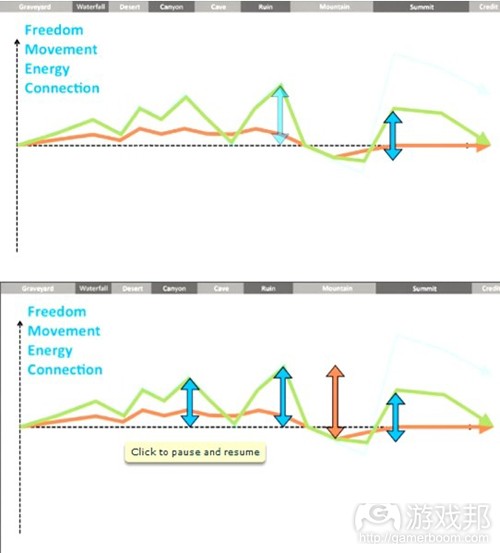 悲剧的高潮2
多出的一整年 所以我们多花了一年的时间,就是为了解决这个问题。我们做了什么来增加最后的高潮呢? 首先,我们要确定在爬山的关卡,最后情感升起之前的关卡,情感要进入足够的低谷。  情感低谷
原本的山是平缓而又沉闷的,因为只有一大股风在吹着你,你要花很久才能走过。我们希望把它变得更加挑战和艰苦。我们设计了一整套全新的人物动画,那是几百个动画效果。我们就为了让玩家在这一关感觉很脆弱的迎着风走,而做了这些。你会看到角色很缓慢的爬,很缓慢的跳,很轻的发出呼唤声。我们还修改了围巾和衣服的质地,当它们被冻结时,它们变得沉重,没有生气。 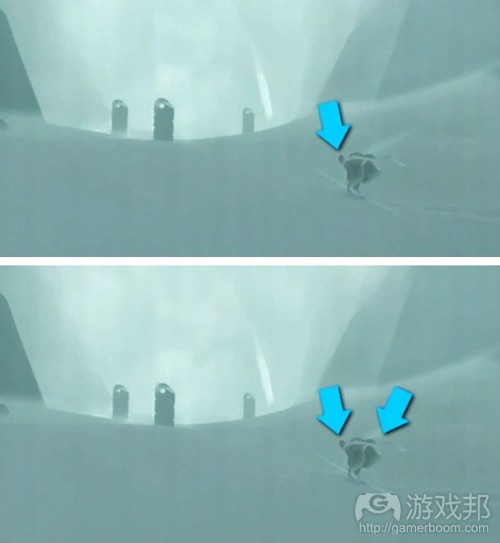 场景1
在这个场景的中间,守卫的龙,平时飞在高高的天上,杀死其他的生命,不攻击你。但在这里我们让它攻击你,在之前关卡里可以用来躲避的地方,现在也坏掉了,不再安全。 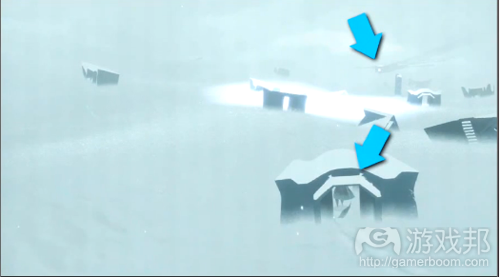 休息的避难所
我们还需要让玩家在这一关花更多的时间,从而更加艰辛。我们增加了两个新的区域来拓展关卡的长度。有一个可以短暂休息的避难所,但是前面有更多的艰难区域需要走过。 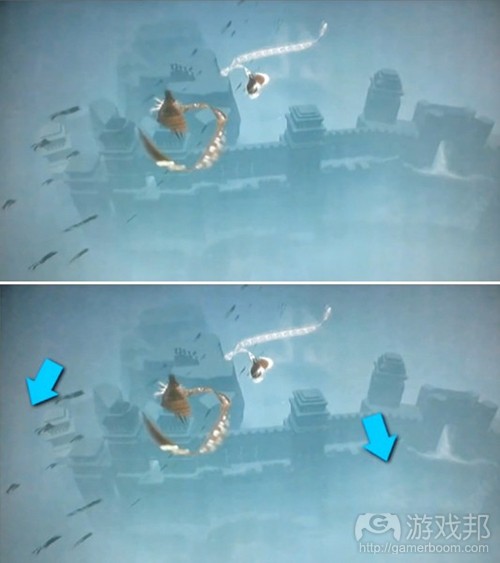 场景3
最后当你到达了走向死亡的场景。为了让这个区域更符合我们的期望,我们逐渐的降低了玩家的输入的反馈速度。我们让灯光渐渐暗下来,因为灯光是希望和目标的象征。当你死去的时候,就彻底没有了希望。我们花了非常多时间来平衡需要走的时间长度。我走的时候,感觉3分钟不错。但是我的团队说,这太长了。它们希望是30秒。我认为30秒不够,玩家还没有进入到我们设计的情绪中。所以我们不断的协调,直到找到最合适的时间。 然后,我们来修改最后山顶的关卡,让这个顶峰更加激动人心,更加高潮,更加自由。什么是一个高潮式的情感紧张度呢? 最初山顶是这样的。在第二年的最后,这整段体验像是在轨道上,你只是沿着轨道走,看到所有东西,没有很多操作空间。 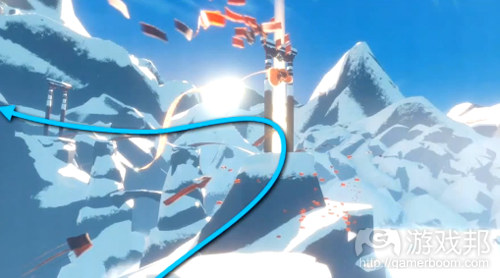 飞行不够有趣
我觉得这种控制的缺失,正是游戏不够高潮的原因。因为尽管视觉上这是一个游戏成品,但从玩法讲,它并不是。你没有自由,不能移动到你想去的地方,这一定不对。所以我们取消了这个既定的轨道,改为你可以去任何地方。我们增加了一段滑行的区域,因为我们知道飞行不够有趣。我们让你再次体验滑行的乐趣,从而创造兴奋感。 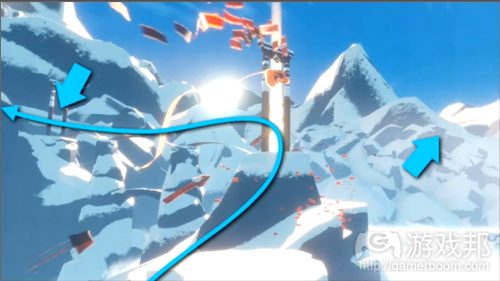 自由感
当你一路走向最终的光明时,我们始终保持你的自由度。你可以走下去,你也可以去任何地方。一切都是你的决定,直到最后。我认为这种自由度是极端重要的,因为想想《旅》中的小高潮,不管是划沙还是水中寺庙,以及最终的山顶飞升,你总是在体验快速运动和自由感。 25人中的3人 最终我们完成了这些,直到第三年结束。这时候我们找了25个玩家来测试,其中有3个在结尾时哭了出来。这太让我们激动了。因为我们知道我们创造的情感体验真的做到了。在那之前的玩家测试中,玩家总是迷路,不知道干什么,或者被卡主。我们做的测试多数是可用性测试。但是我认为情感体验的玩家测试是至关重要的,但是不幸的是,除非你大功告成,否则你测不出来。我非常希望能够有一种更好的情感体验测试方法。 游戏发布的情感旅程 当我们发布《旅》时,我非常紧张,因为我们花了太多太多时间制作这个游戏。我们这个项目延期了两次,最后我们甚至拿出自己的钱来保证我们能完成这个游戏。这值吗?我们不知道。你在这个游戏上做了这么这么久。  情感旅程
当我们发布这个游戏的第一天,我们就感到非常的释然。玩家在我们的论坛上发帖,为他们自己因为种种原因未能和同伴一起完成整个游戏而道歉。他们在游戏中没法告诉对方。所以他们来论坛发帖。我无法想象一个主机玩家会这样做,但是这确实是同样的一群玩家。 当你玩这个游戏时,慢慢的你的围巾和斗篷会变色,你变成了一个老手。 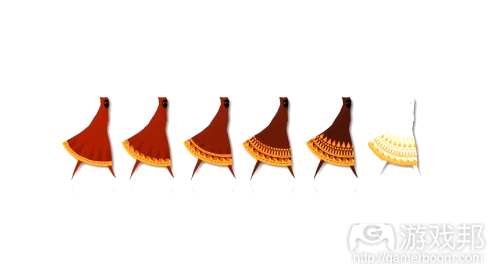 围巾和斗篷变色
我这里有很多我们的粉丝画稿和大家分享。因为我觉得在粉丝画稿中很好的看到玩家对这个游戏记得的是什么。他们总是记得那些最紧张最高潮的情感。  最紧张最高潮的情感
他们记得他们在游戏的结尾画出心形。 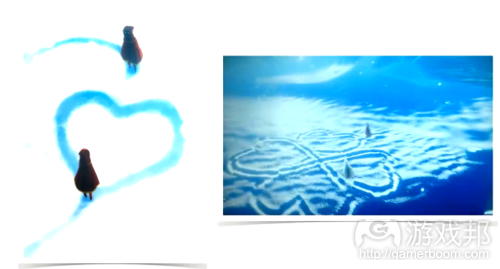 心形
他们记得这个游戏世界的敬畏和绚丽。 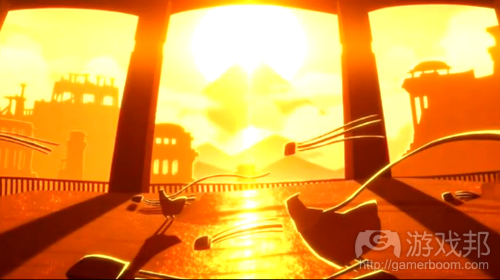 绚丽的游戏世界
他们记得对危险的恐惧。 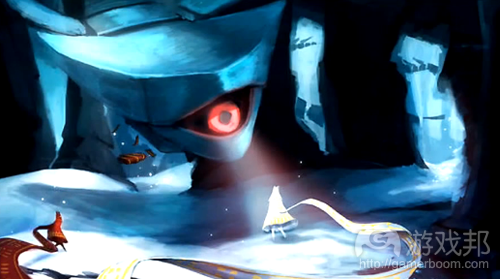 对危险的恐惧
他们也记得挣扎着互相帮助走到最后。 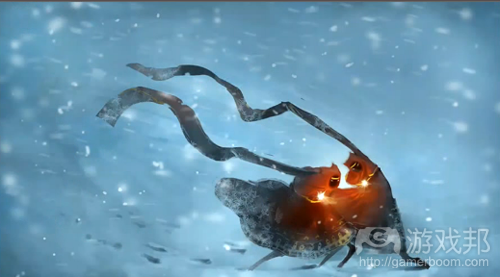 玩家相互扶持到最后
在获得这么多游戏奖项之前,我还是一直怀疑,一个游戏做三年是否值得。到今天为止,我们共有896封粉丝发来的邮件,告诉我们他们个人的故事,和他们如何和游戏互动的。在今天分享的最后,我将分享这一封邮件。 你的游戏确实改变的我的生命。这是我和他一起最大的快乐,自从他被确诊以后。。。我爸爸,2012年春天过世了,在确诊之后仅仅几个月。 他过世几周后,我终于能够让自己走出来一些,自己玩游戏。我试着玩《旅》,我看到那开始画面,就大哭起来。在我和我爸爸玩《旅》的过程中,我发现这正是关于他,和他走向人生终点的旅程。我相信我和我爸爸在最完美的时机遇到了你的游戏。 我想感谢你,因为你的游戏改变了我的生命。它的美丽让泪水盈满我的眼眶。《旅》很可能是我玩过最好的游戏。我持续的玩,一直记着它所带给过我的快乐,和它将持续带给我的快乐。 我叫索菲亚,我15岁,你的游戏让我的生命更美好。 看到这封信,它把我带回到这幅粉丝画稿。我想这就是生命的意义。我们只存在这么一小段时间,我们恰好活在同一个时代,让我们互相帮助,让我们共同使他人的生命更美好。因此,作为一个游戏开发者,我认为这是我能做的最好的事情,这也是我为什么热爱制作游戏。(本文为游戏邦/gamerboom.com整理发布,转载请注明来源) So designing Journey. Journey took us 3 years to make. But the company, That Game Company started in 2006. In the first 3 years, we were making other games. You know, so far we’ve made 3 games on PlayStation Console, Flow, Flower and Journey. This is the Journey team at the end of the development. Here is the celebration, and we’ve made scarves for every member. It’s a small team. There are 12 people here. When we started making Journey, there were 7 guys after the finish of Flower. You know, over the course, various people come and leave. Most of them were on the stage last night. Actually before Journey, we’ve already kind of made quite a few awards, which I’m proud of. And after Journey it’s kind of going crazy. But what I’m most proud of, is these kind of association of game with museums and art and some other industry giving our game nominations and awards. Because deep down, I always want games to be accepted by, I guess, the mass? how did your guys do it? A lot of people asked us, how did you guys make it? You didn’t have a PR apartment. Your CEO in the news all the time. Well, I guess it’s the difference is we view game development in a very different perspective. I remember in GDC at 2004 or 2005, we were talking about innovating games around gameplay mechanics. There are different ways you can innovate games. You can use new technology and build games around it. You can create unique art style and build games around it. But when we approach innovation, we like to look at it from the perspective of emotion.interactive media I kind of see games as an entertainment. When I think about entertainment as a whole, I see a kind of industry to fulfill human desire. Just like food and water. When a human has a craving for emotion, there are various ways to get it through various media. It just happened to be interactive media can provide entertainment, uh, can provide various emotions. Compare games to films. If you look at films which has grown quite mature and the genre of the films are often divided based on the feeling, from negative to positive. Emotional Palette When we look at video game genres, and particularly the early video games. These are what I consider as arcade era, even though Angry Birds and Bejeweled are here, I consider these games that are very popular in the early days. These games are about the sense of accomplishment. You really get better at performing certain skills and the feeling of achievements is really a powerful emotion that is often not achievable in cinema. I think that is why in early age, this emotion has been explored a lot. And over the past 20 years, games have become bigger and bigger and particularly console games. With the teenagers and the younger male. And you take a look at the games appealing to this particular age group, a lot of them are about empowerment. Particularly when we think about what this group of people need, most of the time in school they were told not to do certain things. At home, they can’t drive, they can’t drink, they can’t. These schools leave a lot of limitation about freedom, so in a way, a feeling of freedom is something that really appeals to this age group. But as I grow older, I have the freedom, I have a job, I have the money. I can go anywhere I want to. I such find it’s less appealing to me and I start to play less and less games. If you look at the innovation on emotion in the history of video games, I can recall a couple, for example Sims. Sims is the first game that gives me a feeling of socializing with someone. That is huge. That’s like before multi-player even existed, this single player game can give me the feeling of connection and relationship. I think that’s why it has huge hit and it has very different appeals to different demographics. So when we started ThatGameCompany, we want to push the boundary of what kind of emotion can games communicate to the players. If there is a variety of feelings that’s attainable in gaming, it is going to be a healthy media, it will make gaming a more healthy media. And for players, if all the play is empowerment, if there is a new feeling, it can also be healthy for them. Journey So now I’m gonna talk about Journey. This is why you are here. In early 2006, this is before ThatGameCompany was created, I already have this idea for Journey. At the time it was the 3rd year I play WOW, I started to play since early alpha because my friends work in Blizzard and I felt super privilege to play this game before everybody. But it is the time I started getting really sick of WOW. And the reason is that most of the time I was very busy at school, and there is almost no social life. So being online, being with other people, the real people, they are on the Internet, is something that makes me feel close, and makes me feel less lonely. When I play a game online, what I want is emotional exchange with each other. I want to have romance and friendship. But most of the time, the player doesn’t care about those things. They like to talk about the strategy, how they are supposed to kill the boss, like: move up to left, you’re slow. All they were saying is that I want to loot. This is my turn and you are not supposed to get it. So I was kind of disappointed because the more I play this game, the more people I encounter, the more I realize I have no connection with any of these people. It just remind me that I’m a lonely person. It’s sad. I was hoping that there will be a different type of game out there that will satisfy me desire, to have a connection with people. As you can tell, I’m an introvert, I don’t like to go to parties or bars. So I was imagining the online world where there is no longer difference between…, first of there is no enemies you can kill and there is no … like armor sets. You know I’m platinum and you are only bronze. I want everybody to forget those material things and focus on the fact that we’re all human. The other thing I got quite annoying is that a lot of people will check to see if you are a guy or a girl in these online games and it’s always a sad ending. I really wanted to see a game where there’s no difference in gender or age. Sometimes I realize this guy I really have connection to during play and raids is actually a 12-year old boy, I suddenly felt like such a disappointment. I want to see a world that everybody is the same. You can’t tell what their gender is, they are all on their path searching for something, something I don’t know what that is. So I have the scene here where one person is simply standing on the bridge and looking down in the waterfall and I’m just imagining a scenario where I can walk up to him without words and he is staring at the waterfall and I decide to stop, looking at the waterfall and thinking why he was looking there, the very action of stopping next to someone and not keep moving on. Give me a feeling that at the moment we are together for this. And back down I was thinking about MMOs because what I was playing was WOW, so there are supposed to be lots of players. This scene is something I really liked and I want to see in the game one day. It’s basically just finished? Shadow of the Colossus. How ridiculous is that. So in the scene, there are dark pillars actually the legs of the giants. They are walking through the snow field, kicking all the dust. So it’s very foggy and dusty and you can’t see in the front. And you guys have to keep silent because if you make noise, the giants will notice you. You have to slowly contract through the way and relying on the guy before you to lead you away from danger. And at the same time, being relied on upon by the person behind you. That is some feeling I really want to experience in this game. Money But we have no money and no banking company back then. We are very very lucky to be able to find the opportunity to work with Sony. They helped us to build the previous 2 games. Flow took us a year, Flower 2 years. So when we finished flower, we say OK, finally let’s make a third game and I feel we finally ready to tackle online gameplay. We want to take what we learn from Flow and Flower and try to induce a new emotion between 2 strangers online. When we think about emotion-we’re going back to dispatch here. We mentioned social game like sims. This is also the era at 2009 when facebook got big and the social games got big. People talk about social games. I looked at the social games. I looked the mechanics interactions. It’s not about socializing. It’s more about exchanging numbers and resource management, which reminds me more of the earlier games. And when I think about social emotions, Sims is one of them. When playing Guitar Hero, I have a great social bonding with people who play with me. And even play Minecraft, well Minecraft is recent but I’m trying to say that they are interactions that make you social. My habit with previous games is to try to make emotion that’s stronger and different. I really know that it’s some emotions there that gonna bind people. They’re gonna have deeper emotions of the finished game. But I have no idea what is the emotion. Identify the emotion It takes us quite a while to search for what is the emotion behind social interactivity. So I first look around at the online games that’s popular on the console. There are a lot of team fights, or team survival co-op. It was very interesting for me to look at what is the average noise. People keep telling me how they hate online players. And people are mean online and don’t want to know who they are. I really want to make something that feels differently, or make people trust each other better. I was very lucky to have a met with quite a few astronauts(Charles F. Bolden Jr.) in my life and talked with them about the experience in the space. They talked about how there is a weird myth between all the astronauts who went to the moon, that after they came back, they all become very very spiritual and religious. That’s like a joke I heard from the lunch table, right? There must be something mysterious about the moon that really transform these people who were at there. And later on I met the guy who jove the first moon buddy. I asked him what’s so special on the moon, that makes these people feel different after they come back. He said, on the moon, there is nothing. There is no sound because there is no air. It’s elderly quiet. The earth is so small. It’s like you put your thumb there and you can cover it up. And you are on the strange place where there is nothing, no sound. You can’t stop but thinking ,why. Why are we here? What about the rest of the universe? Everything you know, these astronauts, they are mostly scientists, they know a lot about earth. All of a sudden, they are facing with a lot of unknown. I learned psychology and I know that sense of awe and unknown is directly tied with a lot of religious meanings. It’s kind of inspiration you cannot connect to what the game is. But it inspired me to look at our life today. We are kind of super empowered by technology and knowledge today. We can move really fast, we can live and walk above the clouds. We can talk to anybody at anywhere and anytime. And in our pocket, our bag, we carried the entire knowledge that human has ever gathered. It makes me feel powerful because if I got to bring things today to 10 years ago, they will think that I’m a god. I know everything, I can do everything. But also it kind of makes me feel like we are living in a life we are trapped by these empowerment. We can’t simply live without them anymore. When we look at video games, particularly the popular commercial games, most of the characters are carrying something that symbolize power. The gameplay, as I mentioned earlier, is mostly about empowerment. When you have empowerment, when you put a bunch of people in that environment, their first reaction is that I’m gonna apply my power on someone else. If you give me a gun, and you lock me up with another guy in a room, I think I’m gonna use it someday. So the problem is when you have a lot of power, even though the game is about to be survival, and bonding, and collaboration, most of the time you apply the power on, let’s say shooting someone to death, and if my teammates block me, I’m like, uh, get away, I’m gonna shoot this zombie. The only time I felt connection while I play Life or Die, is when someone is patching me up and I really feel something. But too bad, it’s rare. The majority of time, I’m still applying power. Redesign online experiences So when I think about redesign a social experience, something that will connect people together, I think the very first important thing is to reverse the power relationship between the players and the world. The player needs to be less powerful and the monster needs to be more powerful. And then you will think about collaborating with other people. And in a lot of games today, it’s most about achievements, and challenge about conquering the monster. Make the monster logo looks like the angel logo. It has no indication here. So I’m trying to see in a online game, most people think about getting items, and getting power, and think less about the other player, particularly in WOW, most time I don’t think about a player only when I think this guy is too difficult to beat. I need another guy to help me beat this boss. And I kind of think them as a tool to get the treasure afterwards. I want to see a reverse. I want to see the treasure and the monster only be a mean to make me realize how awesome the other players are. In most of the online games, it’s about shooting. But I want to see an online game where the skills a player gain and improve every time is communicating emotions and really feel each other rather than how accurate your gunshot is. The problem is trying to create that world is very difficult because in a lot of modern day games, the scene of war is too noisy. You just don’t have time to look at the other friend when the tank, the helicopter is attacking. So I thought, it’s easy, the first thing we do is to remove the noise. We just keep a game to focus on people. Then we have the problem that if you have a gun, you want to use it. So we have to ditch that. Then it starts to get interesting. A bunch of people in a lobby waiting before the rites started and talk to each other. But I kind of want to have more structure so I think what if we have less people. It’s easier to design when you have less people. Let’s say we are in a hazardized environment, not many people can survive. And there is only two people left. And then all of a sudden, this guy in this distance become very interesting, compare to constant warfare or action. That’s the very beginning of Journey. We want to have a game which will make you feel somewhat lonely, somewhat small. But you have a great sense of awe, and the feeling of unknown, towards this mystery behind this game world. Prototyping the emotion That’s just the emotion we have indentified. But to actually accurate that emotion, we have to do a lot of prototype because not seeing a lot of games trying to achieve that, maybe Myst, Shadow of the Colossus is the only two I can see that is having the similar feeling. Music When we prototype, actually we start prototyping music. It’ not the interactivity because music is the most effective and powerful media that can create emotion. So I work with Austin Wintory, BTW he is Grammy nominated. I was really really lucky to have a music that he made. Pretty much like the right beginning of the game development. 4 month So 4 months into Journey’s development, Our artist make this mock-up trailer with Austin’s music. I’m going to play it here. You can see in the early days, our character looks like a ninja. He still have human shape like arms. It’s very much the early stage. But we know the world it’s make you feel big and inspiring. You need to feel awe. It’s kind of various landscape. You can hear the music. That’s the music we use in the end game. It’s the music you will hear on cross media before we launch Journey. It has not changed and hit something strong and I really feel there’s something there. And we kind of start to build the game around the music. And the mountain used to be a gravis of canyon rather than a hill. experience through the development Early prototype Then we start to enter all kinds of round problems. I think the trailer is only successful in the early day. Let me show you something we learned. Coop Works Against Single Player We start prototyping with co-op(cooperation). We want people to work with each other. So we start this prototype called rope. So basically it’s a one button game. You just press Space(空格键). Rope is the action. A long light guy can’t break the rock because he doesn’t have arm. But the fat guy, he has strength, he can break a rock. But still the chance is not always 100%. So as they collaborate, here is the rope, they can climb up. The long light guy runs fast and can jump through gaps. With a rope, anybody can launch a rope at any time. Eventually was the chance they can collaborate. We thought this was a great game. You help each other. But the problem is you can’t play alone. Sony keep telling us that this game could have a great multi-player, but needs to have single player. Otherwise, you will not sell your game. So we are like, OK, this doesn’t work. Here is an example where two people are collaborating and they are pushing a heavy rock. This is a common feature I think most collaborate games have. But if you are alone. You can’t even finish this level. Even though there is a great feeling of collaboration, it become a great trouble for us when we want to design a game that’s possible to play alone. 2D doesn’t translate to 3D The other thing, as you can see most of prototype earlier times like JAVA and flash are 2D prototypes. And stuff we saw was brilliant, didn’t work in 3D at all. We start this idea of a trail. If you walk in the desert, you can only see so far from top down. How would you that there is another player? And even if the other player exists, they are moving towards one direction, how you’re ever gonna catch up if you all have the same speed? So if you walk on other people’s trail, you would speed up. And so, eventually, as you explore, you will run into other player. You can see the shots in very earlier prototype, we thought that was successful. Here I’m trying to show you that if the player can be next to each other, they will be more strengthful and they climb rocks. But these mechanics, eventually when you transfer into 3D, it’s almost impossible to put it out because cameras and other things. Here is another prototype. We saw it smart because when two people are travelling, they get to go faster because they can leave frog from each other, and they can increase speed. Another great idea we had, we thought was smart, was calling to distract the monster. In Journey, you see the monsters, right? If you shout at them, the monster wanna attack you. So between the two players, you might be able to collaborate and distract the monsters and to get through. But when we actually try to execute this idea in 3D, it’s almost impossible to tell the distance between you and the monster and coordinate. This is way too hard. It tells me that a top down view is great for strategy menuval and collaboration, but it’s almost impossible in 3D. Here is another scenario which we really saw as great idea but got killed. We saw the desert and of course the sandstorms. So sandstorm is coming and people have to find shelter. The shelter is kind of a grey color. You can see the sandstorm keep going. If they stay at the shelter too intimately, the color of them will change to pink. I don’t know what that means, maybe they are shy. So this very scene of the sandstorm wiping the entire world was very powerful emotional experience but in the end when we bring it to 3D, we realize how difficult it is to actually do a sandstorm. Graphics is Gameplay And there is also this idea about graphics as gameplay. This is something very unique in TGC(Thatgamecompany) where internally we call it Grameplay. We are more a grameplay company than game mechanics company. What do I mean? So imagine you are in the desert and you’re walking towards a mountain in the distance. And you’ve been walking, the mountain is so far that almost nothing changed on the screen. This is how it feels early on in Journey where we have to keep jopping breap crowns to keep the player feel like I’m actually making some progress. The world is so big. We want to feel epic. But it’s really boring to traverse through the land. For a quite long time we feel this game is not fun at all. In order to create feedback, for simple traverse like walking, we added the sun trail. At least you join something, you can sense how long you’ve been walked. We want to have a lot more like dunes, things that will be passing by. So when you walk, the entire screen is giving you a feedback rather than just staring at the image. We went out to a really kind of desert. This is the Pismo Beach. Here is a video our leading engineer John Edwards climbing the sand and I’m like if you jump off the sand, can you actually slide down? So here I’m telling him, hey let’s try this, let’s try just jump off and see what’s gonna happen. And he jumps down and just stopped. How terrible is that! I wish in the ideal world he would just be sliding down and that’s what we did exactly in Journey. You climb up, it’s kind of slowly. And then eventually you kind of slide down the other side. It’s kind of wired that we try to catch realism but we’re trying to catch realism we wished. Then walking become interesting because every dune you climb up, you have this patience of what’s behind it. You also have a reward. There is a lot more engagement in the basic grument. There is no mechanics here, really. Just feedback. Avoid Emotional Distractions As we work on this game, we went out to a lot of distraction. As a good designer, you need to be very clear about the experience you want and stay the hell away from those you don’t want. So Journey is a very simple interface game because we want to make it for everybody. We want to kids to be able to pick up this game to play. We want to give this to my dad or my mom and they should be able to just enjoy it rather than learning a lot about game. When I think about online game, the first thing I think about is the online interface. This is Journey’s online interface. There is another guy. So you know it’s a online game. When I think about the online games, before we made this game, it was like this. You have to figure out a lobby, check out a room and check everybody’s pin number and make sure it’s all green and you start the game. And you have to say ready. I just don’t know how to explain what is a pin number to my mom. So we say we have to hide all these interface. And the next problem, is just the user ID. Because players have been playing the aggressive, competitive games, their names tend to be very aggressive. This name is actually not too bad. They actually take me out of the game. Haris Pilton, I’m seeing Haris Pilton, I’m seeing real world. It takes so much efforts for us to transfer the player in the living room into a magical realm. And these names, these texts, just bring them back. In order to have them collaborate and connect, they have to forget these realized things. And the next thing is people will say, oh online game, I get to talk to my friends, I need to have voice chatter. Knowing console games, I just don’t want to hear the voice of the 12 years old boy. Who knows who’s playing the game on the other side. Sony was talking to us that if you have friends invite, you will have a viro marketing(病毒传播). Because it’s fun to play with friends. They will tell other players to buy the game. We thought this was a good idea but when you implement that, if you have two strangers on the internet, and they can’t chat, they can accept that. But if I’m playing with my best friends, and he’s on the internet, and we can’t chat, it’s kind of frustrating. And because of that, we actually decide not to support friends invite because it will break the integrity of the world. The only way we allow players to connect with each other is at the very end of the game, after all the player roles we show you the ID of the other player. So that way, we can protect the feeling between the strangers. Social Distractions The other distraction is in the early days, we try four players call up. We realized there are a lot of weird situation. After they play for a while, they start to talk about us verse them. They suck. We agreed. I think, sure, having competitions is great for online games, but that’s not the emotional connection I’m thinking about. And a worse case is when there are 3 players in a bigger group and this single player is isolated. I remember talking to my professor Tracy Fullerton who is sitting here, and she told me she hated this game. Because she is an explorer. She wants to explore the game but all the other testers want to move on. And she felt forced. She has to conform herself towards others. So in the end we start to focus on one on one interaction. Also based on that particular problem that the 3 verse the one, I want to bring this idea of collaboration and flow. Collaboration and Flow I originally learned flow from the single player game because you know as a psychology theory, flow is about the balance between the player’s abilities and the challenge of the game. You want to make sure no matter where the player evolves in the game, they are in this nice balance. But also, there is the concept of flow for collaboration. Coliberation, which is like in any group co-up, there is the balance between individualism and the group conformity. You can’t just be too much about yourself, then the group will abandon you. You can’t just do what the group wants to do then you lose yourself. The player needs to have the choice to actually navigate through the experience to stay in the flow and also to stay in the flow of collaboration. That’s really why we tried really hard to create Journey’s seamless online lobby system. We will match you up with all kinds of players. But some of them might not match with you. They might want to explore while you want to finish the game as soon as possible. We believe if you have the choice to walk away from a player, eventually you’ll run into someone who wants the same thing, the similar type of player. Then you would love to be next to the player. When you have the choice to leave, the co-up is more real and sincere, it’s possible to have a stronger emotional connection. In the end, Journey’s online matching system is based on the physical distance. If someone is close to you, we’ll match you up, if you don’t like them, you start to walk away, the system will disconnect them and find someone else. Resource Distraction Another type of distraction, resource. In Journey, you go through and pick up those cloth, strength, and you fly, and you love them. When two people who loves strength, they meet, and one guy take the resource, and he flied. The other guy hates you. In fact, in our early days play testing, people will say like I really don’t want to be with the other player, they don’t belong here because they’re gonna steal my resource. For quite a while, in order to compensate, we thought we had a great idea, we had the player who jump the resource after use that. They don’t actually consume resources. This is the early days 3D prototype, you can see the players flies, he jumps the strength behind them. So for the other player, he can just pick them up and fly up for free. It’s kind of like a coming thing. You share all the resource. But the problem is that even though mathematically you share it, psychologically you don’t. A lot of players complain how epic he got all these resource carry all the way to the other guy, and he can use my resource to fly. He take the advantage of my labor, even though most of them are not intentional. And a lot of people feel very weird when there’s a guy stuck you, stay behind you and pick up your stuff. They still feel like some kind of stealing happening. In order to really eliminate that, at least people don’t hate each other, we decide to jump the idea of percetion of resource. We just have infinite resource, except the player has limited pocket size, can only carry this much money. People go through resource, they pick up their money and they can all fly and they don’t hate each other. Physical Distraction And then, at some point, we have another distraction from physics. In most online games, there is no collisions, so people can just walk through each other. Because collision online is very difficult to do and it causes all kinds of problems. At some point, we talked about the two people helping each other to go through the rock. You can see the 2D prototype is very easy but to do this in 3D you need to carry the guy, push him up and the other guy pull you up. So there is a lot of collisions, physics we have to be permitted. We thought, but this would help people trust and help each other even more. Let’s do this. This gonna make the emotion deeper. So we add the physics so the player can push each other, they feel the existence of each other. This is great. But instead of helping each other push them to the rock, they push them to something more exotic. For quite a while, I thought those playtesters, they play too much Call Of Duty, they’re just mean. And then, we were doing playtest at our own office, our leading engineer, John Adams who jumped off the sand, killed me, multiple times. Wait, you know this game is about helping each other and having connection, right? Why are you keep doing this? He was just staring at me laughing because we are just right across the office, come on, revive me. Then I realize, for quite a while, I was just disappointed about humanity. I was so disappointed and one day Kelly told me to meet her brother’s girlfriend. She is a spiritual psychologist. So I talked to her about the very dilemma of humanity. She said oh, it’s because you are players. They are babies. What do I mean by that? When you transfer yourself from real world to a virtual space, particularly when character looks like adults, they don’t carry the morality from real life. It’s like a new baby. A baby only seek for feedback. And pushing a guy to a rock has almost no feedback. But pushing a guy to kill him, there is animation, there is blood, there is a sound of crying and there is social anxiety of waiting you to revive them. It’s so much more rewarding. Of course the player wants to do that. So what I learn is morality doesn’t necessarily carry over and in order to shape players’ behavior, you have to control the input and output. In order to prevent this happen, we actually get rid of collision in the end. So what happens is that instead of pushing each other, when you’re next to each other, you start to give each other money. So people love to be next to each other because there’s a lot of feedback but there is no feedback by pushing them into a cliff and kill them. And now they can both fly just being next to each other. They love each other. These little twigs about features can go a long way. There is so many small things about Journey kind of like constantly playtesting before this start working. Executing Emotional Catharsis And now I’m going to talk about I think the most important thing in Journey: if you wish to figure out about mechanics, you really need to push for emotional catharsis. And catharsis is kind of like what people will say a climax of a great story. But what’s important for catharsis is it’s not emotion, it’s just an intensity. I think no matter what emotion you are pushing for, whether joy or sadness, all kinds of emotions. You need to push to a certain depth, a certain intensity. Because otherwise adults, like myself as a gamer I’m too jaded. I need to be really shaken, really surprised, to actually feel something. Three Act Structure So this is a typical three-act structure from Hollywood: how you would structure the intensity of your emotion in your story, hoping at the very end, there is a huge rise. And that rise, is a change of intensity. That’s the catharsis of emotion. Awe & Mystery/ Structure of Transformation You know, for Journey, the feeling is awe and mystery. We want to be able to control that. This is where I sought to look for Joseph Campbell’s work. He is a master about myth and awe. This is where I get to learn the hero’s Journey in depth. I keep hearing it but never pay attention to it. The hero’s Journey is essentially a structure of storytelling about a transformation of human being. They can be something like a transformation of a farmboy into a galaxy saver, or some hacker guy turning into the One. It could also be useful for more abstract stories like the transformation of the little lion into the king. So when I lined up the transformation of the hero’s Journey, which is called the monomyth, with the intensity of three-act structure. I’m thinking about doing a transformation of a character’s life from birth to death. It’s surprisingly a line. It’s almost like perfect a line. It’s such a great three act story about a hero’s journey which is also a human’s life. At that point, I’m so kicked down. This is so perfect. People all figureit out long time before we look for cinema and audio things. We have to try it out as a game. So we create arch of Journey, and based on the arch, we create the landscape, the world of Journey, which you can see from the altitude, it’s almost like based on the arch. Then we figure out the character’s growth from young to old, and they eventually transcend. And based on the story line, we create the mood and colors. The detail of every areas in the world. And based on that, we have a even more detailed emotion arch with gameplay elements classified in this chart, and divide these archer into smaller levels. This is all finished in the first year, the first happy year. Basically, we break audience those? down into small scenarios that gameplay elements, storytelling elements and the history elements. There is actually two story line for Journey. You can see based on this arch, we can have this intensity curve here. If I map it onto an axis, you can see basically we can use that as a guide to direct what we want in terms of gameplay. So on the positive side of the intensity, we want to make the player feel free. We want them to have lots of movement. We want them to feel energetic and feel connection with each other. And in the opposite, you can imagine what kind of emotion that is. When we work with artists, it’s very easy to tell an artist to paint something that’s in a very intense or very low. It’s easy to work with composers to get music that feels sad or happy. But it’s very hard to work on controls and gameplays, because what is a sad gameplay? There’s almost no reference. As game designers, we have a lot of vocabulary to refer from all the games in class about how to create a sense of fun, a sense of achievement and a sense of accomplishment and empowerment. But my knowledge about other emotions is only through the game I’ve done, you know Flow and Flower which is zen like games, love games, and peaceful games. End of the first year So it takes a lot of effort to explore these mechanics, to form the arch. At the end of the first year of the Journey development, the game suppose to look like this. This is a concept art. But this is the game look like. We kind of block it out. And this is the second bridge area which is supposed to look like this. We have basic foundation of this. They actually block out the entire game before the first year. So we have formed mountain level, underground level. Except this is the target of the emotion. This is how it feels. Nothing really makes me feel anything. The game sucks. Nobody have any confidence it’s gonna be well. End of the second year We keep pushing it. This is the trailer we’ve made at the end of the second year. You can see this is very similar with the final trailer, except the sand is not as sparkling, and some of the mod is not very polished. You can see mostly the character is there, the scene is there, and the storyline is almost there. This is the curve we measured at the end of the second year. It’s basically there. We have most of the levels basically there and we have a lot of people to playtest, and the result is not good. And they say the game is really bad. Some people told me before the final heaven level, when the player dies, you should just cut it there. Because the later part is making the game worse. I’m like, what? really? So I looked at the game, and what happened is that if you look at the green curve, this is the final emotional rise. That is not even bigger than the level where the water can floating. That’s not even higher than the sand level. It’s not satisfying. But the guy was saying when he died, accidentally the game crushed. He was just staring at the white screen for 2 minutes with nobody noticing. He was in a deep thinking. He was like this is very serious tragedy.(laugh…) And he really like it. I started to look at why. Actually if you jump from that level to the very bottom and you just died, it’s the biggest emotional change. If you reverse it, it’s actually the catharsis of tragedy. But that’s not what we intended. We are not going to make a sad story here. One Extra Year So we actually took another year, just to fix that problem. What did we do to increase the catharsis? First we have to make sure the mountain, the level before the final rise, is low enough. What we change is the mountain kind of feel shallow and tedious, because it’s just a lot of wind blowing at you, and it takes forever to walk away. We actually want to make it more struggling. We create a completely new animation set. You know an animation set is hundreds of animations. We just make it for this level where you kind of feel weak walking against wind. Climb slowly, jump slowly, and shout weakly. And we change the physics of the scarf and clothes. When they are frozen, they become heavy, they become lifeless. In the middle of the scene, the guardians, the surpence, usually they just stay above, they just kill other cos features? above but they never attack you. We actually make you to be attacked. We make these shelter actually crushed so it’s no longer safe. To extent the amount of struggling, we also need players to spend longer time in the level. So we added two new areas just to extent how long it is. There is a sanctuary which gives you a brief rest, and then there is just fortres? areas you just have to go through. And eventually you go to the final walk of death. To make this area even better, we have to figure out a way to continually slow down player’s input. We actually dimmed down the light, because the light is a symbol of hope and goal, so when you actually die, there is no hope. We spend so much time tweaking the timing. A lot of time I walk, I saw 3 minutes a good time, to walk to a death. And then my team member is like, this is too long. They want it to be thirty seconds. I think 30 seconds is not enough, I’m not even in the right mood yet. So it’s constantly back and forth tweaking about the exact right number where everyone is happy for you to fall down. Then we move to the summit to make sure the summit is a lot more exciting, a lot more climatic, a lot more free. What is the emotion of the intensity? Originally summit looks like this. At the end of the second year, but the whole game is on rail. You just follow the rail, see everything, you don’t have a lot of control. You can star fox? a little bit. But because of that, I think that’s why the game was not climatic. Because even though visually it’s the same as a final game, gameplay wise it’s not. You have no freedom, you can’t move anywhere you want, it’s just not right. So what we did, is we break the rail, end up that you can go anywhere you want. We actually added a surfing area because surfing is the most fun of the entire game, we know it, the fly is not fun. To bring the surf back, just to bring you a feeling of excitement again. And all the way until you walk into light, we kept it free. You can do it. You can go anywhere. It’s your decision. Until the very end. I think this freedom is super important for Journey because if you think about other highs of Journey, whether it’s the surfing part or the water temple, or eventually the summit, it’s always about movement and freedom. 3 out of 25 So eventually we executed and the end of the 3rd year, in the playtest of 25 players, 3 of them actually have tears in the end, which is amazing. Because that’s where we know the emotion is actually working. Before that, all the playtest is just like people get lost, people don’t know what to do here, or people get stuck. And I think while we do playtest, mostly for utility, test for emotion is super crucial, but unfortunately you won’t get it until the very end. I really wish a better way to test those things. Launching an emotional Jouney So when we launched Journey, I was very nervous because we spend way too much time to build this game. We extended the project for two times, and in the end we have to put out our own money just to make sure we can finish the game. If all the things gonna be worthwhile? You just don’t know. You have been making this game forever. It was really relieving the first day we launched the game. People start to post on our forum, to apologize to each other for not being able to play through the whole game because they had to leave. But they couldn’t tell the other players. So they start to leave post on our forum. And I can never imagine a console player do that but they are the same person. So as you play the game, you slowly build your scarf and your cape and you become a more veteran player. And I have a lot of fan art(Fan art or fanart are artworks created by fans of a work of fiction (generally visual media such as comics, movies, television shows or video games) and derived from a character or other aspect of that work. As fan labor, fan art refers to artworks that are neither created nor (normally) commissioned or endorsed by the creators of the work from which the fan art derives.) here because I think fan art is a great way to see what the player remembered about your game. And usually they remember the most intense emotion.and you know this is what they remembered. They draw heart at the end of the game. They remembered the awe and the splendid beauty of the world. They remember being scared and afraid of danger. They also remembered struggle together with each other and helping each other to push all the way in the end. And so before all these award season, I still question whether it’s worth it to push a game to its three. Up to today, we have 896 emails from our fans telling us very personal stories about how they interact with the game. While back and dies, I’ll share this letter. I gonna read it. Seeing this letter, somehow it brought back to me about this fan art. I think it is what life is about. We are only here for such a short amount of time, we happened to be living in the same era, and let’s help each other, let’s make each other’s life better. That’s why I think as a game developer, that’s the best thing I can do and that’s why I love making games.
|